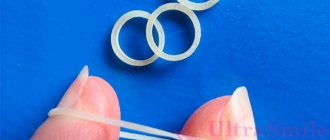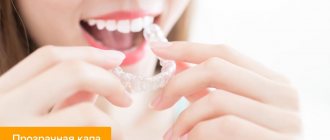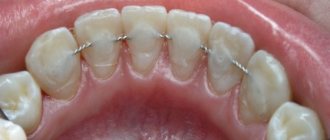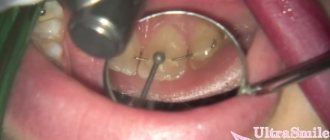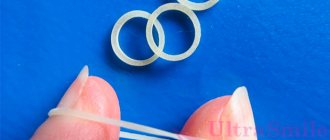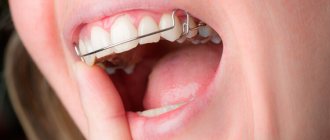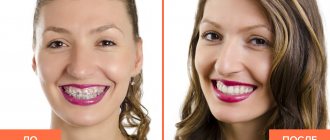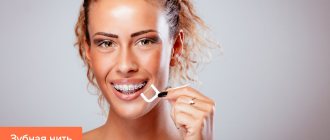Malocclusion is one of the most common problems of the dental system. More than 80% of patients have malocclusion, expressed in one form or another. In many cases, the pathology is not pronounced and generally does not cause aesthetic discomfort to the patient, so the patient is in no hurry to correct the bite in dentistry. It is important to understand that bite problems, even the most minor ones, must be corrected, since any anomaly affects the normal functioning of the entire dental system.
Why do you need a dental guard after braces?
Braces correct the bite. This may take several months or even years. When the orthodontic appliance is finally removed, the patient experiences relief. But not everyone knows that after removing braces, teeth can return to their previous incorrect position. This is due to the structural features of the jaw and the physiology of the body, for which it is natural to resist outside interference.
In this article
- Why do you need a dental guard after braces?
- Types of removable mouthguards
- Advantages and disadvantages of removable aligners
- How is an orthodontic mouth guard installed?
- How long do you wear mouthguards after braces?
- How to care for aligners after braces?
- How to wear mouth guards after braces without damaging them?
- Conclusion
In order to prevent repeated curvature of teeth and to maintain the effect of bite correction achieved during orthodontic treatment, the orthodontist prescribes the patient to wear retainers. These are special structures that are worn during the retention period - a time when there is a risk of the tooth returning to its usual position. Retainers hold the teeth in the desired position and allow the ligaments to “get used” to the new bite.
Retainers are removable and non-removable. The latter are wires fixed on the inside of the teeth. A more convenient and popular option is a removable orthodontic mouthguard - after braces, it is worn only at night.
If there is strong bite resistance, the orthodontist may recommend wearing both removable mouth guards after braces and permanent retainers at the same time. In this case, the wire is worn constantly, and the mouth guard is worn only for a certain time at night or during the day.
A little about bruxism. Why can’t you do without a mouth guard with such a diagnosis?
Bruxism is a disease in which a person clenches their jaws tightly and cannot control the force of their teeth closing.
The problem especially manifests itself at night, when a person is sleeping and does not control the jaw muscles. As a result of such pressure, the teeth are not just worn down, but loosened, the bite is damaged, against which more global dental problems arise, including destruction of the temporomandibular joint. No one is immune from bruxism; the disease can occur:
- due to sleep problems;
- due to increased nervousness;
- against the background of bad habits;
- due to problems with the gastrointestinal tract, etc.
It is important! If left untreated, the disease can lead to serious discomfort, dental problems, and sleep apnea - a pathological breathing disorder during sleep, which is also accompanied by snoring.
Types of removable mouthguards
Dental mouthguards differ in material, duration of wear, and production technology:
- Standard models are made according to one sample and do not take into account the specifics of an individual bite. Therefore, they are rarely used after braces. These types of trays are often used for teeth whitening.
- Thermally modeled retainers. Their peculiarity is that they take the unique shape of teeth after heating. Such a mouth guard is first placed in hot water and only then put on the jaw.
- Individual models are the most accurate and convenient. They are made according to the individual anatomical parameters of a particular patient based on a cast of the jaw.
According to the period of wearing, mouthguards are available at night and around the clock. The first ones are worn exclusively at night and are used in “mild” cases of bite correction. They are worn around the clock, removed only during meals and before oral hygiene. These models are suitable for correcting severe malocclusions.
According to the material, mouthguards can be made of silicone and bioplastic. Both options are distinguished by good hypoallergenic properties, transparency and non-invasiveness.
Who is recommended to wear a mouth guard?
It is important to understand that the condition of the entire oral cavity depends on how many more serious anomalies are present in the patient. Problems such as stomatitis, dysfunction of swallowing and chewing, breathing disorders, facial expressions, tongue injuries and many others are a consequence of malocclusion. Treatment of anomalies must be carried out in a timely manner, using a method suitable for a particular patient. The most appropriate time for correcting malocclusions is childhood, however, it is also possible to correct the position of the jaws in adult patients. Indications for treatment with capami are the same in both children and adults. Indications for wearing a mouth guard include minor gaps between teeth, the presence of teeth that are on top of each other, incorrect position of a tooth or teeth in a row, twisted or rotated teeth, and minor malocclusions. Also, mouthguards for correcting teeth are prescribed as a preventive measure against relapse of tooth displacement after the bite has been corrected with a braces system. The time required for bite correction varies between adults and children. Treatment of malocclusions in children is carried out much faster than in adults. But, for children's treatment, trainers are used to a greater extent, and only at an older age can mouth guards be used. Since the mouthguard is easy to use and can be easily removed and put on, it is often prescribed to adolescents and children aged 10-12 years.
Mouthguards do not cause discomfort or pain, are invisible to people around them, do not affect the enamel and do not injure the gums. Thanks to these factors, mouthguards today occupy one of the leading positions among methods for correcting minor malocclusions. It is worth noting that mouth guards are not suitable for all patients; the individual characteristics of each patient play a large role. If we talk about contraindications to wearing a mouth guard, then it is worth noting such a factor as individual intolerance to the components from which the structure is made. Contraindications also include the presence of problems such as mental and nervous disorders, epilepsy.
Advantages and disadvantages of removable aligners
Caps have many advantages:
- unlike fixed structures, they can be worn for a limited time;
- using mouthguards after braces is more comfortable, since the jaw “rests” from metal structures;
- Oral care is easier if the retainer can be removed.
The main disadvantage of aligners is that they are a noticeable design that affects appearance, so not everyone is ready to wear such retainers during the day. In addition, the design can cause increased salivation.
How is an orthodontic mouth guard installed?
The removable retainer is placed by the orthodontist for the first time; in the future, this can be done by the patient himself. Before the first installation, the doctor prepares the oral cavity for the installation of an orthodontic structure. Checks that the braces system does not damage tooth enamel, evaluates the presence of carious lesions, and covers the teeth with a special protective layer.
A custom-made or thermally modeled mouth guard is placed on the patient's teeth and shown how to remove and put it on independently.
What tasks does the mouthguard cope with?
A dental mouthguard also performs the following tasks:
- an individual mouthguard provides prevention of dental misalignment;
- helps maintain the integrity of the enamel, and, therefore, reduce the likelihood of developing caries;
- reduces the risk of developing the consequences of bruxism, namely, headaches, pain in the projection of the jaw, which can radiate to the back and neck.
Dentistry for those who love to smile
+7
Make an appointment
How long do you wear mouthguards after braces?
The most common question that patients ask their orthodontist is how long to wear mouth guards after removing braces. For each person, the wearing period is individual and determined by the doctor. For some, a year is enough to fix the bite; for others, it takes more than two years. If you want to roughly calculate how long you need to wear mouthguards after braces, you can use this conditional formula.
Take as a basis the time during which you wore the braces system and double it. This will be the approximate period of wearing the mouthguard. Many people wear it for two to four years. But there are also people whose muscle memory “refuses to remember” the new position of the jaw; the process of fixing the bite is very slow. In this case, you may need to wear a mouth guard for a longer period, sometimes for life.
Reflex severity
The gag reflex manifests itself in different ways. It is better to choose remedies to help cope with it depending on the severity.
Mild degree
It usually does not cause serious problems during dental treatment. You can deal with it using the following methods:
- When the gag reflex is psychological in nature, the dentist can simply distract the patient. To reduce your stress levels, you can refocus your attention the night before your doctor's visit.
- If the gag reflex is caused by touching the mucous membranes, the doctor protects them with a rubber dam. This is a latex sheet that the dentist uses to cover the mucous membrane. This way it protects it from contact with foreign objects. The rubber dam also allows you to isolate soft tissue from the diseased tooth, providing additional protection.
- Anesthesia. Anesthetic drugs help not only relieve pain in the mouth. They have a freezing effect, the mucous membrane becomes less sensitive.
Average degree
It is very important here to reassure the patient and reduce his anxiety. Regular local anesthesia will not have the desired effect, since it only numbs the pain. Using general anesthesia in such cases is not always justified.
Sedation helps cope well with the problem of fear and nausea. The patient is given nitrous oxide to inhale through a mask. He falls into a relaxed state, but is fully conscious. This is the advantage of sedation over anesthesia, since the contact between the dentist and the patient is completely preserved.
Severe degree
It is not always possible to cope with nausea to such an extent with conventional sedatives. Such cases are an indication for the use of general anesthesia.
How to care for aligners after braces?
Oral care when wearing orthodontic appliances should be as thorough as possible to avoid caries and other dental damage. Therefore, when installing retainers, the orthodontist must tell the patient how to properly care for the aligners. Below are basic rules for safe cleaning of orthodontic trays and oral care.
The aligners must be removed twice a day during morning and evening brushing. After removing the structure, you must thoroughly brush your teeth with a brush and paste, clean the interdental spaces with floss, floss or irrigator, and remove plaque from the gums, tongue, and inner surface of the cheeks.
The mouthguard itself is also carefully cleaned with a brush and paste, removing plaque and dirt from it. Once every seven days the structure is treated with a special disinfectant. It is also recommended to use mouthwash more often when wearing removable retainers.
Stages
Nausea when brushing your teeth is usually a defensive reaction that is triggered by an irritant, for example, the strong taste of toothpaste. The mechanism of development is quite simple - when cleaning, discomfort is felt, while the person looks at himself in the mirror. A signal is sent to the brain and a reaction develops in the form of vomiting to eliminate the irritant.
The reflex develops through four stages:
- the condition worsens, irritability, fatigue appear, and there is a urge to vomit;
- nausea develops;
- after vomiting there is relief;
- in the intervals between deteriorations, the person feels normal.
How to wear mouth guards after braces without damaging them?
Mouthguards are made of plastic material, so they can be easily damaged if handled carelessly. In this case, the device will no longer perform its main task - to hold the teeth in the correct position. If it breaks, it cannot be repaired; a new one will have to be made. Therefore, it is important to follow the rules of safe operation.
How to wear a mouthguard correctly:
- To avoid damage, it must be removed before each meal.
- Plastic aligners do not withstand high temperatures well, so you should not drink hot tea, coffee or other drinks with an orthodontic structure in your mouth.
- Between uses, the mouthguards are worn like other personal care products - in special lockable containers. This protects the device from contamination and damage.
- You cannot smoke with a mouth guard in your mouth, because tobacco smoke and tar change the color and structure of the material. The mouth guard becomes cloudy and less flexible.
- The structure is stored at room temperature. Both heat and cold negatively affect its characteristics.
General overview
An unloading tray is an overlay made of elastic material that follows the shape and fits tightly along the entire length of the dentition, the task of which is to redistribute the load on the jaw region. The installed orthodontic apparatus helps relieve pain, eliminate muscle hypertonicity, as well as normalize the occlusal relationship and jaw balance.
The use of biocompatible materials eliminates the development of an allergic reaction and a health hazard when wearing the corrector for a long time. The ease of removal and installation makes the use of the mouthguard comfortable even for patients of a younger age group, and the aesthetic appearance eliminates the psychological problems inherent in wearing permanent corrective structures.

